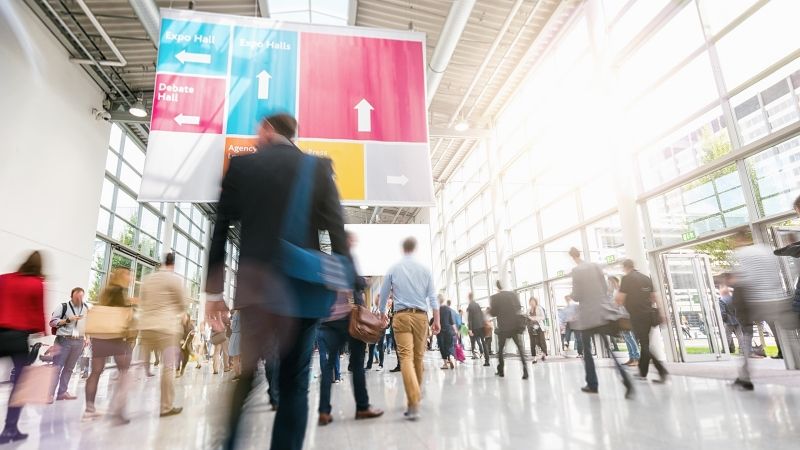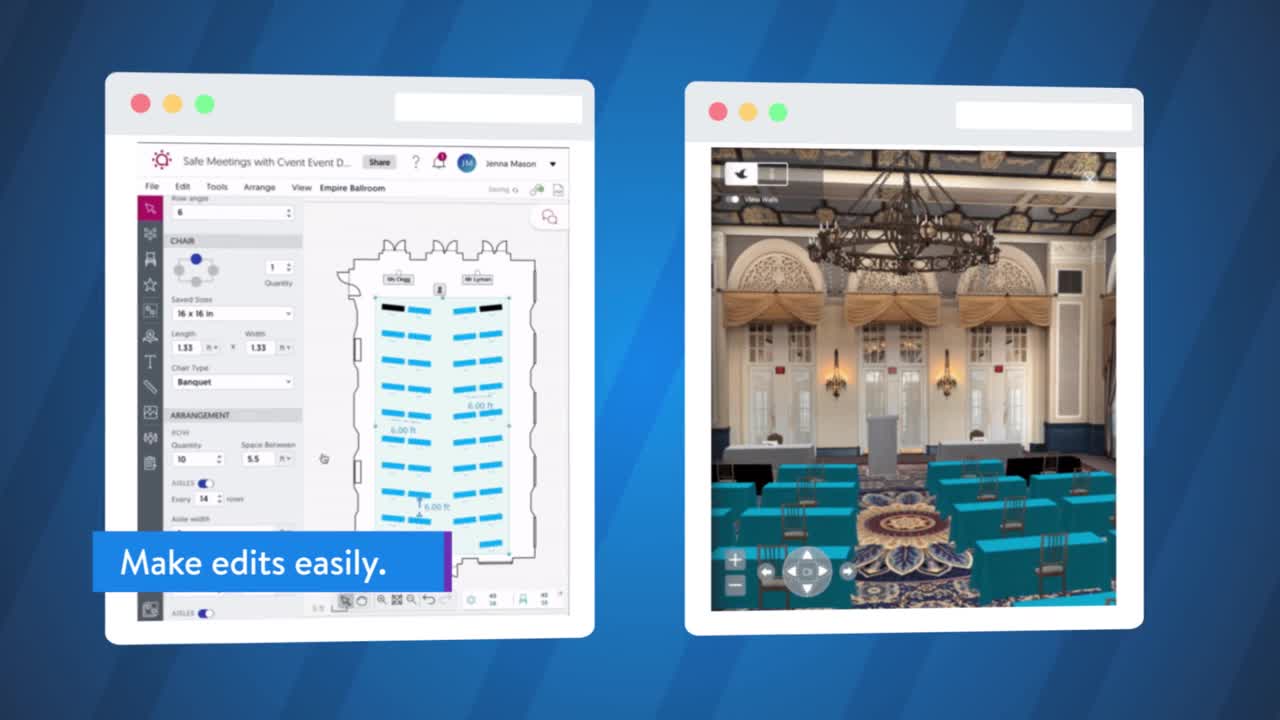Hosting meetings and events in a world affected by COVID-19 has required major adjusting — especially on the part of planners and venues. Venues can focus on a few key areas in order to provide the requirements for safe meetings and events: health and safety protocols, technology solutions, and safe food and beverage, for starters.
In this post, we take a deep dive into safe meetings and events. We explore how venues can fully equip themselves with the tools and resources needed to keep meetings and events heading back in the right direction, share advice and tips from industry experts to help guide you on the road to recovery, and much more.
But before we get started, it's important to note that hotels and venues should stay up-to-date on all local, state, and federal guidelines to ensure that all protocols are being met in order to make safe meetings and events just that: Safe.
Event industry recovery: Where to start with safe meetings?
It’s no longer just about dates, rates, and space. Tomorrow’s meetings and events business is also about safety, efficiency, and transparency.
In-person meetings and events may have been paused, but innovation has been in overdrive, finding permanent solutions to intractable problems like pandemics, and discovering new opportunities to be more efficient at a greater scale of business.
Become an expert on all things safe meetings and events
As the vaccine becomes more widespread, the meetings that will take place in person will likely at first be limited to domestic events and have virtual or hybrid components. Virtual meetings and hybrid meetings are here to stay because they answer the need to meet with more people — more safely and more effectively.
Small, drive-to meetings will also be one of the ways the event industry rebuilds and makes its comeback. These include internal meetings, workshops, and seminars, held locally with attendees from a close geographic area. The meetings will also likely be short, as prolonged, close contact is thought to further spread the virus.
Venues must communicate health and safety protocols
Having a cleaning protocol in place is a crucial element for any event venue looking to book group business and prepare for future in-person events. And it’s not just having the policies that are important – it’s making sure you, as the venue, communicate that plan to event professionals.
“Planners aren’t going to learn about it magically,” says Trevor Lynn, Senior Director, Product Marketing at Cvent. “If you don't have a strategy to promote your safety message, there's no reason a planner would know about it. If you commit to safety, commit to getting the word out about it.”
Hotels should communicate their safety protocol as far and wide as possible, in any way that they can. All messaging should shift to the drumbeat of safety first, because building a reputation of safety drives meetings and events forward. Here are a few starter tips:
- Leverage your Cvent Supplier Network profile. Update it with your latest safety protocol and take advantage of Source Safely — a way for venues to share their latest health and safety information with planners.
- Interview guests and write blog posts. Share testimonials from event professionals who were happy with your level of safety. Use content marketing techniques to boost the visibility of your message. Consider adding a microsite and tell your safety story directly to planners.
- Leverage social media to share hybrid event moments and memories. People, and planners, want to see what a successful hybrid event looks like. If you’ve hosted a safe event, show it off and celebrate it as a step toward pandemic recovery.
The key thing: Center all messaging about safety, so that planners don’t waste time wondering whether or not you follow stringent protocols. By using the power of your digital marketing, you can move from “Are they safe?” to “What’s for dinner?” quickly and efficiently.
“Now and going forward, health and safety should be paramount, and venues are pulling out all the stops to put together comprehensive health and cleanliness programs to ensure the safety of their group business guests,” said Cvent CMO, Patrick Smith.
“Our Source Safely information on the Cvent Supplier Network will give them the platform they need to showcase their offerings to the hundreds of thousands of event professionals who source through the Cvent Supplier Network, while giving planners the insights they need to know that the venues and destinations they are considering are safe for their attendees.”
Leverage digital tools and trainings to make meetings and events safer
Time (and vaccines) will help bring clarity to the recovery timeline, but this much is already definite: Suppliers need to embrace technology to make safe meetings and events possible. From realistic diagrams that show room configurations in real-time to digital marketing and hybrid event capabilities, the shape of recovery – and of the future – requires a fundamental change to meetings and events. This change is driven by new planner priorities around safety, and a rethinking of the in-person event experience.
Today, a foundation of cleanliness is the baseline. It now takes more than face coverings and hand sanitizer to reassure event planners that their attendees are safe. As a result, most properties are now developing programs based on the following criteria:
- Use of mobile app technology as a conduit for attendee/staff interaction. Hotels are looking to minimize risks at every guest connection point – and mobile plays a key role. From check-in/check-out via their own devices to food service and almost all aspects of guest/staff communication, these ubiquitous devices are a significant part of the meetings and events recovery. What’s more, mobile integration is a great way to collect data such as guest spending, housekeeping and meal preferences, loyalty points, and more. This, in turn, could drive incremental revenue opportunities.
- Advanced event space configuration to accommodate safety and social distancing. Smaller meetings are taking place in ballrooms designed to fit 300 people – such is the reality of today’s in-person meetings. As a result, room diagramming and interactive floor plans are becoming critical tools – something that’s increasingly front and center with event planners. They want to know how the room will accommodate regulations and still create a good in-person experience.
Use Cvent Event Diagramming tools to ensure you adhere to safety guidelines so you can deliver safe experiences for all attendees and employees. New features within these tools allow users to add custom safety guidelines (attendees per table, distance between attendees, etc.) as well as safety objects, such as sanitization and temperature check stations.
Use diagramming tools to deliver safe meetings and events
- Virtual technology and A/V capabilities used to create a hybrid event setting. According to the Cvent 2020 Q4 Planner Sourcing and Sentiment Report, 67% of planners expect significant support from venues when it comes to enabling the online experience of a hybrid event. That includes things such as A/V, room configuration, and connectivity. Venues need to begin look at events through the prism of virtual and in-person, and search for ways to be collaborative problem-solvers for event professionals.
Cvent also offers trainings for suppliers who are interested in building their digital skills:
Cvent Supplier Network Certification: Event Sourcing Platform
Learn how to improve your venue’s online presence, create winning proposals, and increase RFP conversion rates. This certification is for hospitality professionals who want to prove and expand their digital skills by optimizing their venue's profile to attract more group business in the Cvent Supplier Network (CSN).
Cvent Event Diagramming Certification: Event Planning and Sales Platform
This certification is for hospitality professionals who want to learn how to create and edit diagrams of their venue’s event space, design unforgettable 3D virtual site tours, and collaborate with planners on alternative – and safe – layouts for their events.
Event food and beverage during times of social distancing
When it comes to F&B at events, self-service buffets likely won’t be a viable option for a while. Seated dining could be an alternative option if there are available staff members trained in sanitation and food-handling measures. These extra steps and layers of caution could tack on added costs to F&B, so it’s in venues’ best interest to offer cost-effective solutions for food and beverage at events. One option could be pre-packed meals that attendees pick up from fridges or multiple locations, or have the boxed meals already placed at their seats at the event.
"We've gotten very creative, and I think most people have in this environment," Kathy Masterson, director of sales at Hard Rock Hotel Dayton Beach, said for a Cvent CONNECT Virtual session. "Something as simple as a continental breakfast. Usually it has a fruit display and muffins and danishes and all of these things that are just left out with tongs to serve it. We're actually individually packaging those items now into plastic containers."
Think about how meals will be served at the event: Bento boxes, grab n’ go’s, plated service, and restaurant vouchers. There are many ways to solve the lunch and dinner dilemma. Pre-pandemic, questions were focused on labor constraints, cost, and presentation – not to mention dietary restrictions. Now, planners are also interested in learning about the cleanliness standards of hotel food prep staff – and the protocols put in place by the hotel to ensure minimal touch.
Here are some other tips to consider around F&B:
- Digitize customer engagement and seating. The pandemic has brought forward important changes to the way we interact, and one is leveraging digital tools to ensure safety and improve the dining experience. From restaurant/room diagramming to personalization, more planning and engagement is sure to happen on digital channels.
- Be creative and smart. Turn lunch “grab and go” boxes and social distancing into a picnic at a beautiful outdoor area of the hotel.
- Rethink the dining experience. Turn up the quality and make the experience special. Leverage local produce and offer themed specials. Make a seat at your hotel’s restaurant a special place to be.
Use this information about safe meetings and events to best prepare for the future
Remember, hotels and venues play a key role in the recovery of the industry, which will likely look very different once meetings and events pick back up. Be sure you stay ready so you can deliver safe experiences for everyone involved.








